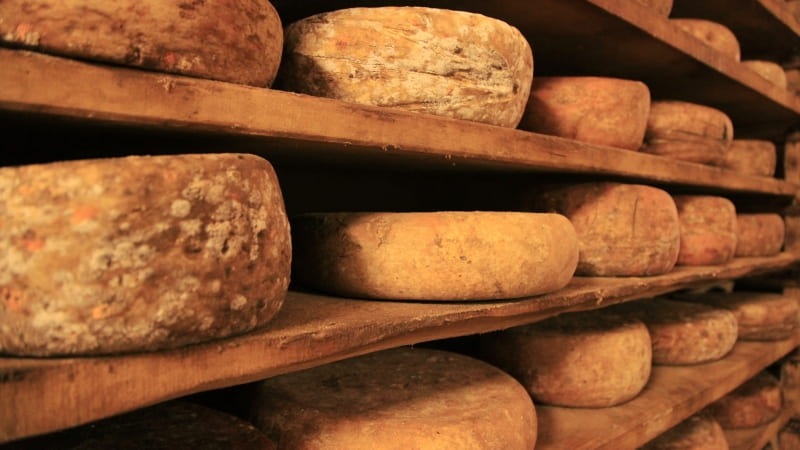MISS MUFFET, MICROBES & MOZZARELLA
By: Hannah Gavin

Aged cheese wheels in Italy, via Pexels
As of now, I’m two-thirds of the way toward one of my life goals: making (and eating) an entirely homegrown Caprese. Popular in Italian-American eateries, Caprese (cuh-pray-say) salad – affectionately known as “tomato-mozz” in my family – is actually devoid of any true vegetable matter. It is composed of juicy tomato, thick-sliced mozzarella, and sweet basil topped simply with drizzles of olive oil and balsamic vinegar.
It was a proud day when I harvested the first ripe tomatoes and a handful of basil from my community garden plot, situated atop a Chicago parking structure. My mouth was watering before I even got home. But the commercial mozzarella in my refrigerator reminded me that I’m still one step away from completely realizing my goal.
Though I’ve as yet to personally tackle mozzarella, humans have been making cheese for centuries. In fact, researchers suspect we’ve been at it since the latter part of the Stone Age. The oldest cheese discovered by archaeologists so far dates to about 1615 BC! In my quest to join the ranks of the ancestral cheese-makers before me, I’ve been reading up on the magical process of converting liquid milk into solid cheese.
My nerdy side was thrilled to discover the scientific underpinnings of cheese making, a practice deeply rooted in chemistry and microbiology. But any fan of nursery rhymes will know something about cheese making without a single science class. Remember Miss Muffet?
Little Miss Muffet
Sat on a tuffet,
Eating her curds and whey;
Along came a spider,
Who sat down beside her,
And frightened Miss Muffet away.
I’m still not sure what a tuffet is, but it turns out that curds and whey are the first products of the cheese making process.
According to the director of the Wisconsin Center for Dairy Research, John Lucey, I’ll only need 2 other ingredients to get from milk to curds and whey: 1) bacteria in the Lactobacillus genus, and 2) an enzyme called rennet.
Bacterial metabolism, a.k.a. fermentation, converts milk sugar (lactose) to acid (in this case, lactic acid). Increased amounts of lactic acid reduce the milk’s pH.
Following this bacteria-induced acidification, I’ll add rennet to the mix. Rennet was originally discovered in the calf stomach, where it helps young animals digest their mother’s milk. Now, humans employ rennet to break down milk proteins into casein.
Casein doesn’t like to be suspended in the acidified milk, so it clumps together with milk fat into globules called…curds! The watery milk remnants that don’t clump, or coagulate, constitute whey.
Depending on the type of cheese that is desired, cheese makers treat curds and whey in various ways: drain off more or less liquid; heat to lower or higher temperatures; add various microbes. Once the right combination of treatments has been applied, cheeses can be formed into any number of shapes, including logs, blocks or wheels.
Cheese aging techniques also dictate the final cheese outcome. Some cheeses are placed in caves (either real or man-made), where they are bound with cloth or washed in salty brines to encourage bacterial growth. The outer part of an aged cheese, usually known as a rind, isn’t actually a static coating or external shell; it’s a thriving microbial community that can consist of bacteria, fungi, and even mites. In fact, cheese rind communities constitute their own burgeoning area of microbiology study. Cheeses can then be aged in their caves for a matter of weeks, months, or even years.
Varied combinations of these few treatments yield hundreds of cheese varieties including sharp cheddar, pungent blue, or crumbly, 36-month parmesan.
Fortunately for my appetite, mozzarella is a fresh cheese that isn’t aged at all. I’ll be able to complete the whole process, turning milk into “mozz” in less than an hour! In fact, instead of waiting for bacteria to ferment my milk, I can cheat by adding acid tablets instead.
Either way, following milk acidification and coagulation of my curds, I’ll drain away much of the whey. Then I’ll treat the remaining curds like cheesy pizza dough, stretching and shaping (but probably not tossing) them into snowball-shaped mozzarella balls. Finally, I’ll firm them up by plopping these fresh cheese balls into an ice bath.
I suppose I’ll need to employ a little more patience in my cheesemaking than Miss Muffet, seeing as she couldn’t even get past the curds and whey stage. But I think it will be worth it when I bite into the dreamy combination of homegrown tomato, basil, and mozzarella, knowing I finally achieved my cheesy goal.
